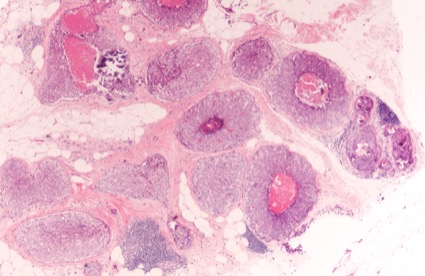
Women with ductal carcinoma in situ and elevated commercial DCISion scores (DS) had a significantly higher risk for ipsilateral breast events and a greater relative benefit from radiation therapy than women with lower scores. These findings come from research recently presented at the Society of Surgical Oncology 2021 International Conference on Surgical Cancer Care (abstract 5).
Radiation therapy after breast-conserving surgery for DCIS is known to reduce the risk for ipsilateral breast events without altering survival, but its use varies widely due to differing assessments of the risk–benefit ratio. Precise assessment of postsurgical radiation therapy benefit would allow individualized treatment decisions.
In the new study, Bruce Mann, MBBS, PhD, FRACS, of Royal Melbourne Hospital, in Victoria, Australia, and his colleagues conducted a validation of a commercially available biological risk signature, DCISionRT (PreludeDx), to assess ipsilateral breast events risk after breast-conserving surgery and the benefit of radiation therapy.
Using a retrospective Australian cohort, Dr. Mann identified 183 women with DCIS who met eligibility criteria. Medical records were reviewed to collect data on treatment and outcomes, and tissue specimens were provided to the PreludeDx CLIA lab for blinded testing of a panel of biomarkers (HER2, PR, Ki-67, COX2, p16/INK4, FOXA1 and SIAH2) scored by board-certified pathologists, and determination of the patented DS.
The researchers used a multivariate Cox proportional hazards analysis to assess the prognostic effect of DS for ipsilateral breast events risk. They adjusted for adjuvant treatments. The predictive effect of DS for radiation therapy benefit on ipsilateral breast events was assessed by the multivariate analysis, including the radiation therapy–DS interaction.
Of the 183 women in the study, 72 received radiation therapy and 66 received endocrine therapy. The total cohort had a five-year ipsilateral breast events risk of 10%. By treatment group, women given radiation therapy had a 4% risk and those treated without radiation therapy had a 14% risk. Among patients treated without radiation therapy, those with a low DS had a 7% rate of ipsilateral events, while those with elevated DS had a 23% rate.
After breast-conserving surgery without endocrine therapy, patients with low DS had a nonsignificant difference of 2% with and without radiation therapy, while those with elevated DS had a highly significant 27% difference, indicating tumor radiation sensitivity. Findings were similar when all patients were included—2% and 20% absolute differences with radiation therapy.
“This validation in a contemporary cohort supports previous findings that DCISionRT provides prognostic and predictive information to allow personalized treatment decisions,” Dr. Mann said.
Dr. Mann reported no relevant financial disclosures.
This article is from the May 2021 print issue.



Please log in to post a comment